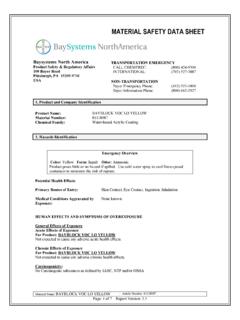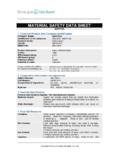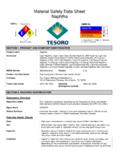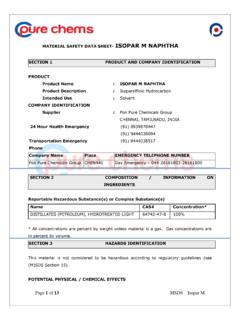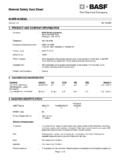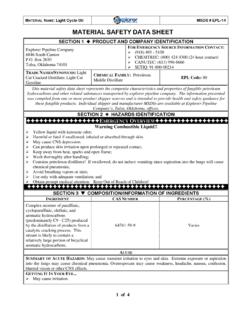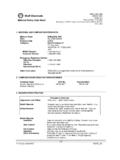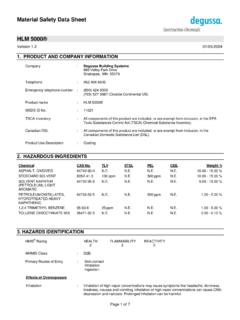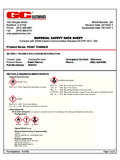Transcription of MATERIAL SAFETY DATA SHEET - bayerweb.com
1 MATERIAL Name: DESMODUR W Article Number: 591932 Page: 1 of 10 Report Version: MATERIAL SAFETY data SHEET 1. Product and Company Identification Product Name: DESMODUR W MATERIAL Number: 591932 Chemical Family: Aliphatic Diisocyanate Chemical Name: Dicyclohexylmethane-4,4'-Diisocyanate Synonyms: methylene bis(4-cyclohexylisocyanate) CAS-No.: 5124-30-1 Formula: C15H22N2O2 2. Hazards Identification Emergency Overview DANGER! Color: Clear Form: liquid Odor: Odorless. Toxic gases/fumes may be given off during burning or thermal decomposition. Closed container may forcibly rupture under extreme heat or when contents have been contaminated with water.
2 Use cold water spray to cool fire-exposed containers to minimize the risk of rupture. Causes respiratory tract irritation. May cause allergic respiratory reaction. Harmful if inhaled. Respiratory sensitizer. Lung damage and respiratory sensitization may be permanent. Causes skin irritation. May cause allergic skin reaction. Skin sensitizer. Animal tests and other research indicate that skin contact with diisocyanates can play a role in causing isocyanate sensitization and respiratory reaction. Causes eye irritation. May cause lung damage. Potential Health Effects Primary Routes of Entry: Skin Contact, Inhalation, Eye Contact Medical Conditions Aggravated by Exposure: Skin Allergies, Eczema, Asthma, Respiratory disorders HUMAN EFFECTS AND SYMPTOMS OF OVEREXPOSURE Inhalation Acute Inhalation For Product: DESMODUR W Bayer MaterialScience LLC Product SAFETY & Regulatory Affairs 100 Bayer Road Pittsburgh, PA 15205-9741 USA CALL CHEMTREC: (800) 424-9300 INTERNATIONAL: (703) 527-3887 TRANSPORTATION EMERGENCY NON-TRANSPORTATION Bayer Emergency Phone: Call Chemtrec Bayer Information Phone: (800) 662-2927 MATERIAL Name: DESMODUR W Article Number.
3 591932 Page: 2 of 10 Report Version: Diisocyanate vapors or mist at concentrations above the TLV or PEL can irritate (burning sensation) the mucous membranes in the respiratory tract (nose, throat, lungs) causing runny nose, sore throat, coughing, chest discomfort, shortness of breath and reduced lung function (breathing obstruction). Persons with a preexisting, nonspecific bronchial hyperreactivity can respond to concentrations below the TLV or PEL with similar symptoms as well as asthma attack or asthma-like symptoms. Exposure well above the TLV or PEL may lead to bronchitis, bronchial spasm and pulmonary edema (fluid in lungs).
4 Chemical or hypersensitivity pneumonitis, with flu-like symptoms ( , fever, chills), has also been reported. These symptoms can be delayed up to several hours after exposure. These effects are usually reversible. For Component: Dicyclohexylmethane-4,4'-Diisocyanate Expected to be highly toxic by inhalation. May cause allergic respiratory reaction with symptoms of coughing, wheezing, shortness of breath, bronchospasm, and reduced lung function. May cause respiratory tract irritation with symptoms of coughing, sore throat and runny nose. Chronic Inhalation For Product: DESMODUR W As a result of previous repeated overexposures or a single large dose, certain individuals may develop sensitization to diisocyanates (asthma or asthma-like symptoms) that may cause them to react to a later exposure to diisocyanates at levels well below the TLV or PEL.
5 These symptoms, which can include chest tightness, wheezing, cough, shortness of breath or asthmatic attack, could be immediate or delayed up to several hours after exposure. Extreme asthmatic reactions can be life threatening. Similar to many non-specific asthmatic responses, there are reports that once sensitized an individual can experience these symptoms upon exposure to dust, cold air or other irritants. This increased lung sensitivity can persist for weeks and in severe cases for several years. Sensitization can be permanent. Chronic overexposure to diisocyanates has also been reported to cause lung damage (including fibrosis, decrease in lung function) that may be permanent.
6 Skin Acute Skin For Product: DESMODUR W Causes irritation with symptoms of reddening, itching, and swelling. Can cause sensitization. Persons previously sensitized can experience allergic skin reaction with symptoms of reddening, itching, swelling, and rash. Cured MATERIAL is difficult to remove. For Component: Dicyclohexylmethane-4,4'-Diisocyanate Causes irritation with symptoms of reddening, itching, and swelling. May cause allergic skin reaction with symptoms of reddening, itching, swelling, and rash. Chronic Skin For Product: DESMODUR W Potent skin sensitizer. Once sensitized , an individual may react to direct skin contact or even to airborne levels below the TLV with reddening, swelling, rash and in severe cases blistering and hives.
7 These symptoms may be immediate or delayed several hours. Animal tests and other research indicate that skin contact with diisocyanates can play a role in causing isocyanate sensitization and respiratory reaction. This data reinforces the need to prevent direct skin contact with isocyanates. Eye Acute Eye For Product: DESMODUR W Causes irritation with symptoms of reddening, tearing, stinging, and swelling. May cause temporary corneal injury. Vapor may cause irritation with symptoms of burning and tearing. For Component: Dicyclohexylmethane-4,4'-Diisocyanate May cause irritation with symptoms of reddening, tearing and stinging.
8 Chronic Eye For Product: DESMODUR W MATERIAL Name: DESMODUR W Article Number: 591932 Page: 3 of 10 Report Version: Prolonged vapor contact may cause conjunctivitis. Ingestion Acute Ingestion For Product: DESMODUR W May cause irritation; Symptoms may include abdominal pain, nausea, vomiting, and diarrhea. For Component: Dicyclohexylmethane-4,4'-Diisocyanate Symptoms of ingestion may include abdominal pain, nausea, vomiting, and diarrhea. Carcinogenicity: No Carcinogenic substances as defined by IARC, NTP and/or OSHA 3. Composition/Information on Ingredients Hazardous Components Weight % Components CAS-No.
9 >=95% Dicyclohexylmethane-4,4'-Diisocyanate 5124-30-1 4. First Aid Measures Eye Contact In case of contact, immediately flush eyes with plenty of water for at least 15 minutes. Use lukewarm water if possible. Use fingers to ensure that eyelids are separated and that the eye is being irrigated. Then remove contact lenses, if easily removable, and continue eye irrigation for not less than 15 minutes. Get medical attention. Skin Contact Immediately remove contaminated clothing and shoes. In case of skin contact, wash affected areas with soap and water. After washing, cover affected skin area with polyethylene glycol (300-500 molecular weight) and wash again immediately with soap and water to thoroughly remove polyethylene glycol and residual isocyanate.
10 Repeat if necessary. Get medical attention immediately. Wash clothing and shoes before reuse. For severe exposures, immediately get under SAFETY shower and begin rinsing. Inhalation Move to an area free from further exposure. Get medical attention immediately. Administer oxygen or artificial respiration as needed. Asthmatic symptoms may develop and may be immediate or delayed up to several hours. Extreme asthmatic reactions can be life threatening. Ingestion Do not induce vomiting. Wash mouth out with water. Do not give anything by mouth to an unconscious person. Get medical attention. Notes to physician Eyes: Stain for evidence of corneal injury.

